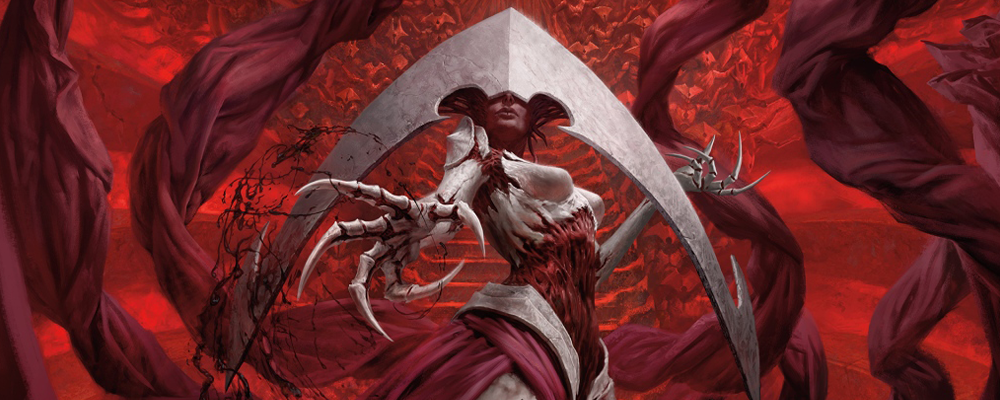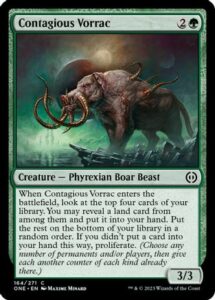My First Take on Phyrexia: All Will Be One Limited

Phyrexia: All Will Be One has arrived. I’m sure many of you went to your local pre-release. While I did not, I did spend a lot of time watching the Limited format, using draft simulators, and trying to get a grasp of what the format is all about.
My initial thoughts mirror those of everyone else. The format seems aggressive, and the games are fast paced. We’d expect no less when a mechanic like toxic is introduced, but it leads the format into a weird place.
Normally, you evaluate cards by colors in a draft format. The ultimate goal is to reduce the opponent’s life total to 20. In Phyrexia: All Will Be One Limited, additionally we have this mini-game of trying to corrupt the opponent, giving them three poison counters to make our cards better.
This means we have to both evaluate cards by color and their roles within the archetype we’re trying to draft. Creatures with toxic are much less valuable in an RG Oil counters deck, and creatures with oil counter synergies are much less valuable in a deck focusing on toxic.
Personally, I don’t like this. It creates a bit of variance. You could set yourself up well to get rewarded for drafting a specific archetype like RG Oil and get powerful toxic green cards passed to you as your reward.
While I’ve only watched drafts and used the draft simulators, it felt like too many decks could end up an Arnold Palmer of toxic and non-toxic. The same is true with UW’s theme of trying to maximize artifacts. While there is overlap in all of it, you’ll want extremely focused decks in a format that is this quick.

There were a lot of cards at common that look strong on rate, such as Contagious Vorrac and Quicksilver Fisher. While both cards are playable, and the Vorrac is even good, it doesn’t appear to be the mythic common some were making it out to be. In the case of the Vorrac, proliferating early is not as valuable as doing it later, and your early creatures not advancing your plan of either setting up oil counter synergies or dealing toxic damage makes it less valuable.


You want to stay focused in this format, and cards that are in the Arnold Palmer half-and- half category don’t have as much value. You want to take cards early that are setting up your plans and commit to a plan rather than try to hedge by taking less-focused cards less because you’ll end up with too many cards that aren’t focused. Initially, I’ll have blinders on when picking and sticking to a direction.
Because of the proliferate mechanic, creatures with toxic that cost one or two mana are more valuable. The first poison counter will allow your proliferate to add a counter. This means you want to get that first toxic counter on the opponent as fast as possible to gain value from your proliferates and you should also be defending yourself from that first toxic counter more aggressively than the second or fourth. The third counter corrupts you, so you need to be wary, as the third counter is obviously the most detrimental.
Formats where cheap creatures are where you want to be typically means removal has less value. Trading down on mana is not ideal, so spending three mana to kill a two-drop is problematic. Cheap removal goes up a bit in value, as winning on the draw is more difficult if you’re just trying to block.
While the gameplay has not appeared all that fun to me, I’m reluctant to rate the format as bad because I think it’s a little deeper than it seems. Time, repetitions, and watching the best at the Pro Tour figure out potentially unique strategies will shed light on this format’s capabilities.

After watching early access, watching Martin Juza do a few drafts, and drafting on the simulator, if I wasn’t playing the PT, I may just hard pass on this format, as I think Limited is at its most interesting when it’s not just about combat. Limited is a unique space where creature combat is more commonplace and interesting, but it’s more fun when it’s about drafting around a specific strategy that isn’t just attacking. Being able to block efficiently, interact with favorable spells, and play fun build-around strategies is a core component to my favorite Limited formats.
My first experiences were all within the MTG Arena. This tends to heavily advantage decks that play lots of one-drops and cheap cards because of the hand smoother. This may make drafts feel more aggressive than they actually are, especially when there are a lot of playable one-drops. Draws don’t break down as often, and curving out is too commonplace.
Quick Drafts, where you draft with bots, may paint a different picture of the format than drafting with people who are well practiced. My first time watching Martin Juza do this, I noticed all the cheap toxic creatures go much later than they would in a real draft. This leads to more focused toxic decks, which wasn’t happening in the few drafts I saw people play against other humans. It’s a small sample, but the format may be more disjointed and streamlined as it develops and some key cards will be taken higher. Decks may end up looking worse, and maybe that will enhance the gameplay.
This is mostly theory now. We haven’t seen much of the set yet, and it’s too early to write it off. I hope this format ends up being a lot of fun, but I’m a bit skeptical thus far. This will be my last article until after the Pro Tour, where hopefully I can tell stories of my success. Wish me luck!





